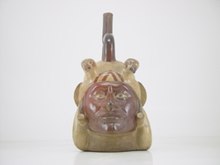Moche portrait vessel: Difference between revisions
convert tag fix |
m added Category:Pre-Columbian art |
||
| Line 15: | Line 15: | ||
[[Category:Moche culture]] |
[[Category:Moche culture]] |
||
[[Category:Peruvian art]] |
[[Category:Peruvian art]] |
||
[[Category:Pre-Columbian art]] |
|||
{{Peru topics|state=collapsed}} |
{{Peru topics|state=collapsed}} |
||
Revision as of 00:55, 3 December 2009

The Moche Ceramic Portrait is a notable piece of Moche art in the Larco Museum, in Lima, Peru. It is noted for being a high-quality ceramic portrait (Spanish: huaco retrato). There have been many articles published that mention it[citation needed] and it has been exhibited internationally in museums.
The ceramic portrait is also an example of a stirrup spout vessel of a Moche ruler. The ruler is depicted wearing a material turban on which there is a headdress decorated by a two-headed bird with feathers on side. The effigy also wears tubular earrings that can be found in the Gold and Silver Gallery section of the Larco Museum.
Origin
The portrait was made during the Late Moche period (c. 600 CE), according to the chronology made by Rafael Larco Hoyle in 1948.
The exact archaeological context in which it was found in is unknown. Nonetheless, information gained from various archaeological discoveries in the North Coast over the past 20 years suggests that it belonged to the tomb of a member of the Moche elite. Archaeologists found this type of headdress, made of reed, in the tomb of the warrior priest god in the Huaca de la Cruz, an archaeological site situated in the Virú Valley, 40 km (25 mi) south of Trujillo, explored by Strong and Evans in 1940. It may also have been excavated from within the Moche Valley in the southern Moche region.
Rafael Larco Hoyle received this piece from his father, Rafael Larco Herrera. It is said[by whom?] that this was the only ceramic piece Herrera kept when he bequeathed his private collection to the Museo del Prado in Madrid, Spain and that Herrera gave it to his son who later opened his private collection to the public at the Larco Museum.
